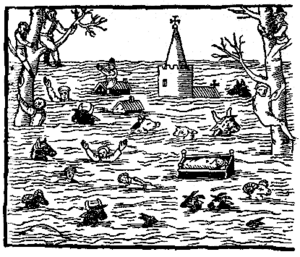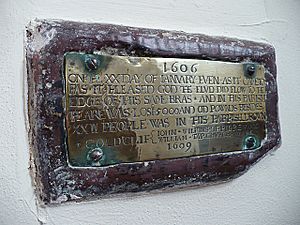1607 Bristol Channel floods facts for kids
The Bristol Channel floods, 30 January 1607, drowned many people and destroyed a large amount of farmland and livestock. The known tide heights, probable weather, extent and depth of flooding, and coastal flooding elsewhere in the UK on the same day all point to the cause being a storm surge rather than a tsunami.
Description
On 30 January 1607, around noon, the coasts of the Bristol Channel suffered from unexpectedly high floodings that broke the coastal defences in several places. Low-lying places in Devon, Somerset, Gloucestershire, and South Wales were flooded. The devastation was particularly severe on the Welsh side, extending from Laugharne in Carmarthenshire to above Chepstow in Monmouthshire. Cardiff was the most badly affected town, with the foundations of St Mary's Church destroyed.
It is estimated that 2,000 or more people were drowned, houses and villages were swept away, an estimated 200 square miles (51,800 ha) of farmland inundated, and livestock destroyed, wrecking the local economy along the coasts of the Bristol Channel and Severn Estuary.
The coast of Devon and the Somerset Levels as far inland as Glastonbury Tor, 14 miles (23 km) from the coast, were also affected. The sea wall at Burnham-on-Sea gave way, and the water flowed over the low-lying levels and moors.
Thirty villages in Somerset were affected, including Brean which was "swallowed up" and where seven out of the nine houses were destroyed with 26 of the inhabitants dying. For ten days the Church of All Saints at Kingston Seymour, near Weston-super-Mare, was filled with water to a depth of 5 feet (1.5 m). A chiselled mark remains showing that the maximum height of the water was 7.74 metres (25 feet 5 inches) above sea level.
A number of commemorative plaques still remain, up to 8 feet (2.4 m) above sea level, showing how high the waters rose on the sides of surviving churches. For example, at Goldcliff near Newport the church has a small brass plaque, inside on the north wall near the altar, today about 3 feet (0.9 m) above ground level, marking the height of the flood waters. The plaque records the year as 1606 because, under the Julian calendar in use at that time, the new year did not start until Lady Day, 25 March. The resultant financial loss in the parish was estimated as £5,000.
The flood was commemorated in a contemporary pamphlet entitled God's warning to the people of England by the great overflowing of the waters or floods.
Contemporary accounts of the flood were written by people such as the Puritan pamphleteer, William Jones:
as soone as the people of those Countries, perceived that it was the violence of the Waters of the raging Seas, and that they began to exceede the compasse of their accustomed boundes, and making so furiously towardes them. happy were they that could make the best, and most speed away, many of them, leaving all their goods and substance, to the merciles Waters, being glad to escape away with life themselues: But so violent and swift were the outragiouse waves, that pursued one an other, with such vehemencie, and the Waters multiplying so much in so short a time, that in lesse then five houres space most part of those cuntreys (and especially the places which lay lowe) were all over flowen, and many hundreds of people both men women, and children were then quite devoured, by these outragious waters, such was the furie of the waves, of the Seas, the one of them dryving the other forwardes with such force and swiftnes, that it is almost incredible for any to beleeve the same....Many there were which fled into the tops of high trees, and there were inforced to abide some three daies, some more, and some lesse, without any victuals at all, there suffring much colde besides many other calamities, and...through ever much hunger and cold, some of them fell down againe out of the Trees, and so were like to perish for want of succour. Othersame, sate in the tops of high Trees as aforesaid, beholding their wives, children, and servants, swimming (remediles of all succour) in the Waters. Other some sitting in the tops of Trees might behold their houses overflowne with the waters. some their houses caryed quite away: and no signe or token left there of them.
Cause
There are similarities to descriptions of the 1953 floods in East Anglia which were caused by a storm surge. A 2006 paper by Horsburgh and Horritt demonstrated that the tide and probable weather at the time were capable of generating a surge consistent with the observed inundation. They point to an exceptionally high spring tide in the Bristol Channel on 30 January 1607 of 7.86m, a severe south-westerly gale with peak winds measured at Barnstaple from 3am to noon, and coastal flooding in East Anglia at night on the 30th consistent with a storm tracking eastwards.
Tsunami hypothesis
An earlier 2002 research paper, following investigations by Professor Simon Haslett of Bath Spa University and Australian geologist Ted Bryant of the University of Wollongong, suggested that the flooding may have been caused by a tsunami, after the authors had read some eyewitness accounts in the historical reports which described the flood. The British Geological Survey has suggested that, as there is no evidence of a landslide off the continental shelf, a tsunami would most likely have been caused by an earthquake on a known unstable fault off the coast of southwest Ireland, causing the vertical displacement of the sea floor. One contemporary report describes an earth tremor on the morning of the flood; however, other sources date this earthquake to a few months after the event.
Haslett and Bryant's evidence for the tsunami hypothesis included massive boulders that had been displaced up the beach by enormous force; a layer up to 8 inches (20 cm) thick composed of sand, shells and stones within an otherwise constant deposit of mud that was found in boreholes from Devon to Gloucestershire and the Gower Peninsula; and rock erosion characteristic of high water velocities throughout the Severn Estuary. The hypothesis is set out in detail in the 2005 BBC Timewatch programme "The Killer Wave of 1607".
However, in attributing the flood to a storm surge in their 2006 paper, Horsburgh and Horritt show that those proposing a tsunami hypothesis underestimate the volume of water and coastal damage involved in storm surges, and fail to account for flooding on the opposite side of the country on the same day. There is also a lack of evidence for the event impacting West Wales, Cornwall or southern Ireland. Their tsunami modelling showed that it would not be possible for a tsunami not to affect these areas and cause flooding elsewhere in the country. Contemporary sources also indicate the flooding proceeded for a period of five hours, which is consistent with a storm surge rather than a tsunami.
Future recurrence
While the risk of similar events in the foreseeable future is considered to be low, it is estimated that the potential cost caused by comparable flooding to residential, commercial, industrial, and agricultural property could range from £7 billion to £13 billion at 2007 insured values. There has also been concern that the nuclear power stations at Hinkley Point and Oldbury could be endangered.
On the 400th anniversary, 30 January 2007, BBC Somerset looked at the possible causes and asked whether it could happen again in the county.



